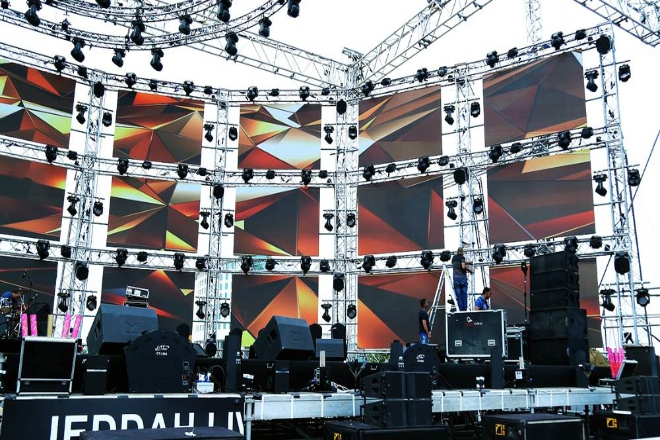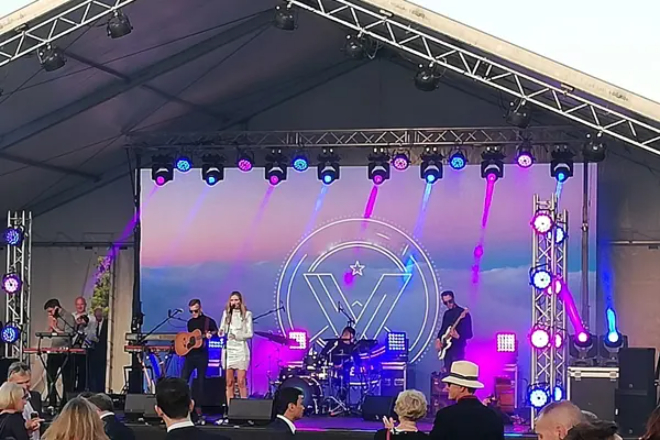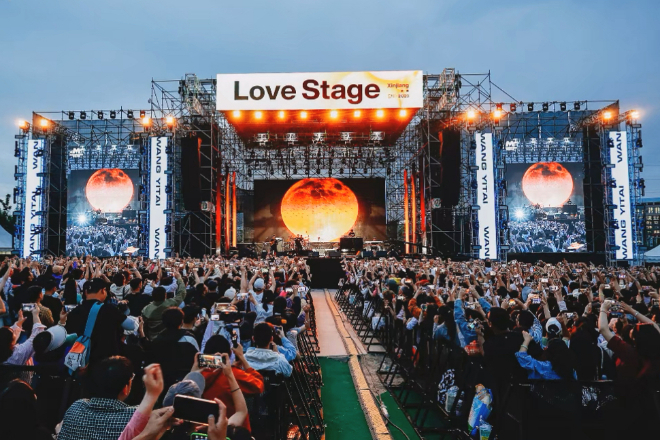Introducción
At the carnival scene of outdoor music festivals, pantallas LED are the soul of the escenario, igniting the enthusiasm of the audience with gorgeous pictures and shocking visual effects.
However, when severe weather such as heavy rain, strong wind, high temperature, low temperature, and even thunder and lightning strikes, how should these displays cope?
Can they still operate stably in extreme environments and bring a perfect audio-visual feast to the audience?
Tabla de contenido
1. The impact of bad Weather on outdoor Music Festival LED Display Screens

1) Tiempo con fuertes lluvias
1.1). Physical damage:
During heavy rain, rain will hit the LED display screen violently.
If the waterproof performance of the display screen is insufficient, rainwater can easily penetrate the screen through the gap, causing a short circuit in the circuit, and the screen will be “paralyzed” instantly.
In addition, impurities and minerals in rainwater will corrode electronic components, and long-term accumulation will accelerate the aging and damage of the screen.
1.2). Performance degradation:
Heavy rain will form a layer of water film on the display screen, just like wearing “sunglasses” on the screen, making the image seen by the audience blurry.
It seriously affects the viewing experience and makes it impossible for the audience to clearly appreciate the wonderful performances of the music festival.
1.3). Safety hazards:
If the screen leaks electricity after being flooded, the audience may be electrocuted when touching the screen or nearby equipment, causing personal injury.
In addition, short circuits may also cause fires, burn stage equipment, and threaten the lives of the audience.
2). High temperature weather
2.1). Physical damage:
High temperature will accelerate the aging of LED lamp beads, just like the skin of people exposed to the sun for a long time will deteriorate, the brillo and color of the screen will gradually deteriorate.
The electronic components inside the display are also very sensitive to high temperatures.
If the heat dissipation system is not good, the internal temperature will be too high, which will cause the circuit board to short-circuit and even cause a fire.
2.2). Performance degradation:
In a high-temperature environment, the brightness and color performance of the screen will be significantly reduced, and the picture seen by the audience may become dim and distorted.
In addition, high temperatures may also cause the display to flicker, skip frames, or even freeze, seriously affecting the visual effects of the music festival.
2.3). Safety hazards:
The risk of fire caused by high temperature is the biggest safety hazard.
Once a fire occurs, it will not only burn the stage equipment, but also endanger the lives of the audience, causing huge economic losses and social impacts.
3). Low temperature weather
3.1). Physical damage:
Low temperature will make the electronic components inside the display fragile and may even be frozen and cracked, just like the freezing and cracking of water pipes in winter, causing the equipment to fail to start and operate normally.
3.2). Performance degradation:
Low temperature will significantly dim the brightness of the screen, and the originally bright picture will become gray, which will greatly reduce the viewing experience of the audience.
In addition, low temperatures may also cause the display screen to respond slowly, and the picture may be delayed or stuck.
3.3). Safety hazards:
Although the safety risks caused by low temperature itself are relatively small, if the low temperature causes the screen to not work properly.
Otherwise, the live broadcast or recording of the music festival may be interrupted, affecting the normal progress of the event and causing dissatisfaction and confusion among the audience.
4). Thunder and lightning weather
4.1). Physical damage:
Thunder and lightning are one of the most destructive severe weather.
If lightning directly hits the LED display, the circuit board will be burned instantly and the screen will be directly scrapped.
Even if lightning does not hit directly, the lightning induction may be transmitted to the inside of the display through the wires, damaging the electronic components, causing equipment failure, or even data loss.
4.2). Performance degradation:
In thunderstorms and lightning weather, the display screen may experience momentary power outages, flickering, frame skipping, or even black screen phenomena.
This seriously affects the live broadcast or recording effect of the music festival, and the audience cannot enjoy the performance normally.
4.3). Safety hazards:
The risk of fire caused by lightning is extremely high. Once a fire occurs, the stage equipment will be burned, and the safety of the audience will be seriously threatened.
In addition, lightning strikes may also cause leakage, increasing the risk of electric shock to the audience.
2. Analysis of the protection design of the LED display screen at the music festival

1). Waterproof design
Waterproof design is the “shield” of outdoor music festival LED display. Generally speaking, if the waterproof level reaches IP65 or higher, the screen can withstand heavy rain well.
For example, the IP65-rated display is not only completely dustproof but also resistant to water jets from any direction, ensuring normal operation even on rainy days.
In addition, waterproof materials and sealing technology are also critical. Like waterproof strips and waterproof coatings, they can effectively prevent rain from penetrating into the interior of the screen to avoid short circuits and damage.
2). Windproof design
The windproof design is mainly to ensure that the display can “stand firm” in strong winds.
Structural reinforcement is the basic operation, such as adding support frames and using high-strength steel, so that the screen can remain stable in strong winds.
At the same time, it is also important to optimize the wind resistance coefficient. Some display screens are designed with special bracket systems to reduce the impact of wind on the screen.
For example, ROE Visual’s Black Quartz series, its windproof system allows the screen to remain stable at a wind speed of 20 meters per second.
3). Lightning protection design
Lightning protection design is the “bodyguard” of outdoor display screens. It is standard to install lightning rods and grounding systems so that lightning can be safely diverted through these facilities and will not directly hit the screen.
In addition, it is also critical to equip the lightning protection module, which can protect the circuit board from lightning strikes and avoid equipment damage caused by lightning induction.
4). Temperature regulation design
The temperature regulation design allows the display screen to “keep cool” at different temperatures.
The heat dissipation system is the “savior” under high temperatures, such as fans and heat sinks, which can effectively dissipate the heat generated by the equipment during operation and prevent the screen from overheating.
In low temperature environments, the application of thermal insulation materials is particularly important, which can prevent the equipment from being frozen and ensure the normal startup and operation of the screen.
5). Protective shell design
The protective shell is the “armor” of the display screen. Weather-resistant materials are the first choice, such as high-strength aluminum alloys and corrosion-resistant plastics, which can withstand all kinds of severe weather.
The sealing and firmness of the shell are also crucial, which can prevent dust and rain from entering the interior of the screen and protect the internal components from damage.
In short, through these protective designs, the LED display screen of the music festival can still operate stably in various severe weather conditions, bringing a wonderful visual experience to the audience.
3. Warning and emergency response to severe weather

1). Meteorological monitoring and warning system
First, a “weather alarm” must be installed at the festival site.
For example, small gadgets such as anemometers and rain gauges can be placed to “track” weather changes in real time, and it is clear at a glance whether the wind is strong or not, and whether the rain is heavy or not.
In addition, you have to “build relationships” with the meteorological department, where they have the latest weather information.
Knowing in advance that there will be strong winds and heavy rains, you can prepare quickly, such as covering and reinforcing the screen in advance, and don’t wait until the weather comes to be in a hurry.
2). Emergency plan formulation
When encountering severe weather, you can’t panic, you must have a “battle plan”.
For example, when a heavy rain comes, you must quickly check the waterproof measures of the screen to see if there are any leaks; if there is a strong wind, you must quickly reinforce the screen to prevent it from being blown down by the wind.
In addition, you must arrange the people, who is responsible for checking the equipment, who is responsible for evacuating the audience, and who is responsible for maintenance, all must be clear.
In this way, once something goes wrong, everyone knows what they should do and there will be no chaos.
3). Quick response mechanism
If you really encounter bad weather, you have to “brake” quickly and stop the equipment first, so as not to let it continue to “suffer”, which can also avoid more serious damage.
At the same time, there must be special people on standby at the scene at any time. Once there is a problem with the screen, such as black screen or flickering, they can go up and fix it immediately.
Tools and spare parts must be prepared on-site. If they cannot be repaired, they can be replaced with new ones quickly. Don’t delay too long; after all, the audience is waiting to see the performance!
4. Precautions for on-site operation of the LED display screen at the music festival

Before the music festival starts, the LED display screen must be fully inspected. Just like checking the tires before driving, every part of the display screen must be carefully checked.
Check whether the lamp beads are broken, whether the circuits are loose, and whether the waterproof and windproof devices are in place.
Debugging is also very important. Adjust the brightness and color of the screen to the best state in advance, and don’t wait until the official performance to find that the picture is wrong.
The power supply is the “heart” of the display screen, and it must not be sloppy. Make sure the power cord is not damaged and the plug is firmly plugged in.
It is best to use a voltage stabilizer, because the power supply at the festival may not be stable, and the voltage may fluctuate, which can easily “burn” the screen.
If conditions permit, prepare a generator so that the screen can continue to work in case of a power outage.
Operating the display screen is not just about pressing buttons casually. The operator must be familiar with the equipment in advance.
Just like reading the guide before playing a game, the operator must know the function of each button and know how to adjust the picture and switch signals.
Moreover, they must be trained to deal with emergencies, such as what to do if the screen suddenly goes black or what to do if an audience member accidentally touches the screen.
The on-site environment changes very quickly, and the operator must pay attention at all times.
If you find that the wind is too strong, check the fixing of the screen immediately; if it rains, confirm whether the waterproof measures are in place.
Temperature is also critical. If it is too hot, turn on the cooling system, and if it is too cold, check the insulation measures.
In short, keep your eyes on the screen and the surrounding environment at all times, and don’t let the equipment “get sick”.
The safety of the audience is the most important. Set up a cordon around the screen, and don’t let the audience get too close.
If the screen falls or leaks electricity, the consequences will be disastrous.
If there are children on the scene, pay more attention and arrange for someone to maintain order.
If there is bad weather, evacuate the audience in time and don’t let them stay in the dangerous area.
The music festival site is dusty and full of debris, and the screen is easy to get dirty. Operators should clean the screen surface regularly to prevent dust from affecting the display effect.
At the same time, check the heat dissipation port of the equipment to prevent debris from blocking it and causing the equipment to overheat.
If the equipment is found to have abnormal sounds or severe heating, stop it immediately for inspection, and don’t force it to continue using it.
In case of an emergency, such as a sudden fire on the screen or an audience member being injured, the operator should remain calm.
Prepare a fire extinguisher in advance and place it in an easy-to-reach place so that it can be extinguished as soon as possible in case of a fire.
If an audience member is injured, contact the medical staff on site immediately to avoid delaying the treatment time.
In short, when operating the LED display screen at the music festival, you must be careful and cautious, be prepared in advance, and be ready to deal with emergencies at any time.
So as to ensure the normal operation of the screen and the audience can enjoy the performance with peace of mind.
5. Conclusión
Through the introduction of this article, we understand the various challenges and coping strategies of outdoor music festival LED displays in the face of bad weather.
I hope this article can provide you with some practical references so that you can have a deeper understanding of the protection design and on-site operation of outdoor LED displays.
Finalmente, si quieres saber más sobre las pantallas LED, Por favor póngase en contacto con nosotros.
Te puede interesar:
Other articles about music festival LED display:
What Are The “Magic Uses” Of LED Screens At Music Festivals?
¿Por qué cada vez más festivales de música prefieren pantallas LED transparentes?
¿Cómo se diseña e instala la pantalla LED en un festival de música?
- …
